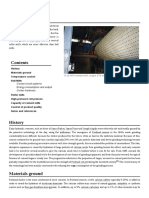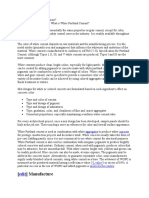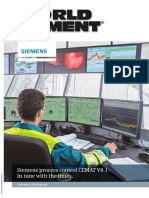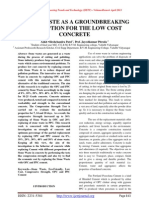Grinding and Milling in Cement Manufacturing: 1.2 Fineness Requirements
Grinding and Milling in Cement Manufacturing: 1.2 Fineness Requirements
Uploaded by
José UrdayCopyright:
Available Formats
Grinding and Milling in Cement Manufacturing: 1.2 Fineness Requirements
Grinding and Milling in Cement Manufacturing: 1.2 Fineness Requirements
Uploaded by
José UrdayOriginal Description:
Original Title
Copyright
Available Formats
Share this document
Did you find this document useful?
Is this content inappropriate?
Copyright:
Available Formats
Grinding and Milling in Cement Manufacturing: 1.2 Fineness Requirements
Grinding and Milling in Cement Manufacturing: 1.2 Fineness Requirements
Uploaded by
José UrdayCopyright:
Available Formats
Grinding & Milling
1.2 Fineness
Grinding and Milling in Cement Manufacturing
1.2
Fineness requirements
The importance of grinding and milling is to ensure the raw materials or the cement
product are in the optimum, finely ground, state for chemical reactions to take place at
the desired rate.
The conversion of the raw materials into the clinker minerals is a sintering reaction
because the majority of the reactants, the CaO and SiO2 and the majority of the clinker
mineral products, the C3S, C2S remain in the solid state throughout the reaction process.
These solid state reactions will only take place at a sufficient rate if the raw minerals are
brought into close proximity with one-another in an intimately mixed and finely divided
state.
In finish or cement grinding we are again making sure that the product is in the optimum,
finely ground, state to undergo chemical reactions at a sufficiently fast rate, in this case
the hydraulic reaction of the cementitious clinker minerals when the cement is mixed
together with aggregates and water to form mortars or concrete.
The surface area which the cement presents determines how quickly it will react, which
in turn determines the heat of hydration, setting time and strength development of the
mortar or concrete. But the optimum, finely ground, state for kiln feed and final
product cement are different.
C2S
For kiln feed it is important that there are no large fragments of the raw
minerals in the feed.
Grains of SiO2 (quartz) are first converted into C2S by diffusion of CaO
into the grains. Then into C3S by further diffusion of CaO into the grains.
C2S
CS
SiO22
C2S
C2S
C2S
C2S
C2S
C2S
But if the grains of SiO2 (quartz) are too large then cores of unconverted
C2S will remain in the centre of the C3S grains.
C3S
C3S
Any unconverted cores of C2S will be balanced by uncombined CaO
elsewhere in the clinker, free lime will therefore be present with potential
unsoundness of cement produced from the clinker.
C3S
C3S
C3S
Similarly any large grains of CaCO3 in the kiln feed, will first be converted into C2S by
diffusion of SiO2 into the grains, then into C3S by further diffusion into the grains.
CaCO3
CaCO3
CaCO3
CaCO3
C3S
C3S
Grinding & Milling
1.2 Fineness
However, large grains of CaCO3 in the kiln feed can leave residual cores of
unreacted free lime in the clinker, again leading to potential unsoundness of
cement produced from the clinker.
The importance of avoiding large grains of raw minerals in the kiln feed is
recognised by the F.L. Smidth burnability equation:
CaO1400C = [0.343(LSF-93) +2.74(SM-2.3)] + [0.83Q45 + 0.10C125 + 0.39R45]
Where:
CaO1400C = CaO content of clinker after firing at 1400C for 30 minutes.
LSF = Lime saturation factor of the kiln feed.
SM = Silica modulus of the kiln feed.
Q45 = Quartz (SiO2) content of the 45 residue of the kiln feed.
C125 = Lime content of the 125 residue of the kiln feed.
R45 = Combined Al2O3 and Fe2O3 content of the 45 residue of the kiln feed.
This formula for burnability recognises the effects of the chemical composition of the
kiln feed (black arrow), and the mineral composition of the kiln feed (blue arrow), and
more importantly the grain size of those minerals as recognised by the 45 and 125
residues.
This is the reason kiln feed fineness is normally controlled to sieve residue targets. The
most common sieves used are a 170 mesh or 90, and 100 mesh, which is ~150, neither
of these correspond with those used in the F.L. Smidth formula!
Irrespective of whichever sieve residue is used for control there is an implicit recognition
that large particles must be eliminated from the kiln feed to ensure full combination of
the clinker. This is the reason why all mills used for raw grinding operate in closed circuit
with a separator.
These separators prevent any coarse particles passing to the
kiln feed by returning any such coarse particles to the mill
for regrinding.
Provided that two different sieve residues are used to
control the kiln feed fineness it is possible to characterise
the fineness and make comparisons irrespective of which
sieve residues are measured.
This is achieved by converting the two sieve residues into the Rosin-Rammler particle
size distribution. This involves plotting the natural logarithm of the sieve grain size (45,
90, 150) etc, against the double natural logarithm of 100/Residue at that sieve size.
ii
Grinding & Milling
1.2 Fineness
Rosin Rammler distribution.
Residue
ln(ln(100/Residue))
Residue on 90 sieve = 15%... therefore ln(90) = 4.5
ln(ln(100/15)) = 0.64
0.1
15
10
0.64
99
0
1
ln(Grain Size)
2.3
4.54.6
Grain Size
10
90 100
Residue
ln(ln(100/Residue))
Residue on 45 sieve = 42%... therefore ln(45) = 3.8
ln(ln(100/42)) = -0.14
0.1
10
-0.14
42
99
0
1
ln(Grain Size)
2.3
3.8
4.6
Grain Size
10
45
100
iii
Grinding & Milling
1.2 Fineness
Residue
ln(ln(100/Residue))
Residue on 10 sieve = 85%... therefore ln(10) = 2.3
ln(ln(100/85)) = -1.82
0.1
10
8
85
-1.82
99
0
ln(Grain Size)
Grain Size
2.3
2.3
4.6
10
10
100
In the fine powder range the Rosin Rammler particle size distribution approximates to a
straight line. This means the residue at any sieve size can be extrapolated from the
distribution. The distribution can be plotted from only two sieve residues as it is a straight
line.
The steeper the Rosin Rammler distribution the sharper is the particle size distribution,
i.e. the larger the gradient m of the line Rosin Rammler distribution line described by
the equation y = mx + c.
A broad particle size distribution has a high proportion
of coarse particles balanced by a high proportion of fine
particles.
A narrow particle size distribution has a lower
proportion of coarse particles balanced by a lower
proportion of fine particles.
0
1
ln(Grain Size)
2.3
4.6
Grain Size
10
100
iv
Grinding & Milling
1.2 Fineness
The slope m of the Rosin Rammler distribution is therefore the first way to characterise
the fineness of a powder.
In this case:
0.64 (-0.14)
4.50 3.81
= 1.13
For kiln feed the slope of the distribution typically ranges from 1.0 to 1.6.
The second way to characterise the fineness of a powder is the position parameter of
the Rosin Rammler distribution, which corresponds to the intercept on the x axis of the
distribution, i.e. when ln(ln(100/Residue)) = 0.
0.1
10
8
Position
parameter
8
99
0
1
ln(Grain Size)
2.3
4.6
Grain Size
10
100
This is the grain size at which 36.8% of the powder is retained on a sieve of that size. i.e.
ln(ln(100/36.8)) = 0. If the equation of the straight line of the distribution is
y = mx + c, then the intercept on the x axis = -c/m exp(-c/m) = Position Parameter.
In this case:
exp(-(-4.44/1.13) = 51.
This example is a relatively coarse kiln feed. If the SiO2 in the kiln feed were present as
quartz then combinability problems could be expected. Quartz is more difficult to grind
than limestone, it has a lower grindability, therefore it will concentrate in the coarsest
fraction of the kiln feed. We will discuss grindability in a later session of the course.
Grinding & Milling
1.2 Fineness
Cements are significantly finer than kiln feeds. Rosin Rammler position parameters of
20~30 would be more typical.
10
8
99
0
1
ln(Grain Size)
2.3
4.6
Grain Size
10
100
Surface area as measured by the Blaine apparatus is the most common method of
characterising the fineness of cements. The Blaine apparatus measures the air
permeability of the cement by recording the time taken for a fixed volume of air to pass
through a fixed bed depth of cement in a standard cell. Blaine surface area is reported in
cm2/g with values for cement being typically 3000~4000 cm2/g.
SI representation of surface area is in m2/kg with typical values for cement being
300~400 m2/kg.
However, with the advent of closed circuit cement mills, high efficiency separators, roll
presses and vertical mills for cement grinding, there is a growing recognition that particle
size distribution of cement is equally, if not more important, than surface area.
All these innovations in cement grinding and milling systems have tended to tighten
particle size distributions of cement, steepening the Rosin Rammler distribution.
All these are subjects we will be returning to later in the course, before doing that we
need to consider separation theory, which we will do in the next session of the course.
vi
You might also like
- Innovations in Portland Cement ManufacturingDocument1,283 pagesInnovations in Portland Cement ManufacturingDébora Bretas80% (5)
- Concrete Blocks NotesDocument16 pagesConcrete Blocks NotesDharshan KNo ratings yet
- Unlicensed Estimate PDFDocument21 pagesUnlicensed Estimate PDFFrancisCunanan100% (1)
- Optimization of Cement Manufacturing Process by Means of Clinker Micro StructureDocument12 pagesOptimization of Cement Manufacturing Process by Means of Clinker Micro StructureARNALDO BATTAGIN100% (3)
- Free SilicaDocument1 pageFree Silicasrinivasu67No ratings yet
- Industrial Waste As Alternative Fuel in Cement Industry: Its Impact On EnvironmentDocument7 pagesIndustrial Waste As Alternative Fuel in Cement Industry: Its Impact On EnvironmentBilal El YoussoufiNo ratings yet
- Chemical AnalysisDocument8 pagesChemical Analysisصفاء رجبNo ratings yet
- Chapter 2. Portland CementDocument14 pagesChapter 2. Portland CementKhaled Al-SwairkiNo ratings yet
- PILLARD AKTUEL Progressive BurningDocument3 pagesPILLARD AKTUEL Progressive BurningSteveih100% (1)
- Bulletin 9 - CFD Analysis and Flow Smoothening in PH Down Comer Duct To Reduce Pressure DropDocument2 pagesBulletin 9 - CFD Analysis and Flow Smoothening in PH Down Comer Duct To Reduce Pressure DropSivaram KrishnamoorthyNo ratings yet
- Optimizing Cement Strength ZKG GermanyDocument5 pagesOptimizing Cement Strength ZKG GermanySarbaz BanozaiNo ratings yet
- CementmaterilsDocument33 pagesCementmaterilsengineeringchemistry100% (1)
- Chemical Technology Subject Code: CH2001Document13 pagesChemical Technology Subject Code: CH2001U SANKAR TEJONo ratings yet
- Cement Kiln Process Chemistry: Module 2. Cement Clinker Quality and CompositionDocument2 pagesCement Kiln Process Chemistry: Module 2. Cement Clinker Quality and CompositionalbertbunguriNo ratings yet
- Coating RingsDocument8 pagesCoating RingsIrshad HussainNo ratings yet
- Ball-Cement-Mill-Monitoring-Inspection-Evaluation Chapter 1Document8 pagesBall-Cement-Mill-Monitoring-Inspection-Evaluation Chapter 1Min MCLNo ratings yet
- Cement Kiln Process Chemistry: Cemnet Training - Course Ckpc01 Module 1 - Session 6Document0 pagesCement Kiln Process Chemistry: Cemnet Training - Course Ckpc01 Module 1 - Session 6breyes25No ratings yet
- Burning in A KilnDocument3 pagesBurning in A KilnNivedithaMuraliNo ratings yet
- Cement Plant ABC: M.ShyamsundarDocument4 pagesCement Plant ABC: M.ShyamsundarayokiNo ratings yet
- Blaine Apparatus ProcedureDocument7 pagesBlaine Apparatus ProcedureVivek Pandey100% (3)
- Cement: N-W.F.P UET, Peshawar 1Document14 pagesCement: N-W.F.P UET, Peshawar 1Angelica Fontamillas SuicoNo ratings yet
- Cement Process ChemistryDocument72 pagesCement Process ChemistryNael100% (2)
- Dinesh Agrawal: Dry-ProcessDocument19 pagesDinesh Agrawal: Dry-ProcessSantanu PachhalNo ratings yet
- The Cement Grinding Office: Home About Us Services Mining Area Links and ContactDocument2 pagesThe Cement Grinding Office: Home About Us Services Mining Area Links and ContactVisnu SankarNo ratings yet
- Cement Mill: History Materials Ground Temperature Control Ball MillsDocument5 pagesCement Mill: History Materials Ground Temperature Control Ball MillsAli HadiNo ratings yet
- The Cement Grinding Office: Blaine Specific Surface Area (Cement Density)Document5 pagesThe Cement Grinding Office: Blaine Specific Surface Area (Cement Density)Anonymous XX9Om322lNo ratings yet
- Department of Chemical EngineeringDocument19 pagesDepartment of Chemical EngineeringPandia RajanNo ratings yet
- Sulfates Topic: Synthesis of The Setting Kinetics ProjectDocument10 pagesSulfates Topic: Synthesis of The Setting Kinetics ProjectcemsavantNo ratings yet
- The Use of Coal As Fuel For Cement Rotary KilnDocument23 pagesThe Use of Coal As Fuel For Cement Rotary KilnDheo Ebhee LouVeNo ratings yet
- Cement AnalysisDocument51 pagesCement AnalysisCHRISTOPHER NSENGIYUMVA100% (1)
- What Is White Portland CementDocument3 pagesWhat Is White Portland CementOliver Raymundo100% (1)
- Chemical Composition & Effect ClinkerDocument8 pagesChemical Composition & Effect ClinkerSiddharth SinghNo ratings yet
- Cement Production ProcessDocument2 pagesCement Production ProcessNishant Ajitsaria100% (1)
- Modelled Fate of Sulphur and Chlorine in Rotary Kilns Part I PDFDocument10 pagesModelled Fate of Sulphur and Chlorine in Rotary Kilns Part I PDFJohn GiannakopoulosNo ratings yet
- TDCC Kiln Fuzzy ReportDocument11 pagesTDCC Kiln Fuzzy ReportbinhvtNo ratings yet
- Analysis of Portland CementDocument4 pagesAnalysis of Portland CementDipmalya Basak33% (3)
- 22 ATC ARA DebottleneckingDocument15 pages22 ATC ARA DebottleneckingmkpqNo ratings yet
- CMS ClinkerBrochureDocument2 pagesCMS ClinkerBrochureSiew LoiNo ratings yet
- Pre-Homogenization Factor PDFDocument6 pagesPre-Homogenization Factor PDFAfqan B-v0% (1)
- Variation of Feed Chemical Composition and Its Effect On Clinker Formation PDFDocument7 pagesVariation of Feed Chemical Composition and Its Effect On Clinker Formation PDFs_prasy6540No ratings yet
- Typical Raw Minerals 202.1Document2 pagesTypical Raw Minerals 202.1Mohammed AbdoNo ratings yet
- 15 Quality Control Formulae: Rs 50 Proportioning of Raw MaterialsDocument2 pages15 Quality Control Formulae: Rs 50 Proportioning of Raw MaterialsDilnesa EjiguNo ratings yet
- Cement Kiln Process Chemistry: Cemnet Training - Course Ckpc01 Module 2.6 ExerciseDocument1 pageCement Kiln Process Chemistry: Cemnet Training - Course Ckpc01 Module 2.6 ExerciseElwathig BakhietNo ratings yet
- WorldCement November 2014 Preview PDFDocument33 pagesWorldCement November 2014 Preview PDFhusam haiderNo ratings yet
- Estimation of The Coating in The Burning Zone PDFDocument19 pagesEstimation of The Coating in The Burning Zone PDFTOULASSI-ANANI Yves Lolo100% (1)
- OvalityDocument17 pagesOvalityquỳnh lêNo ratings yet
- Tube Mill OptimisationDocument7 pagesTube Mill OptimisationJoko DewotoNo ratings yet
- Calculation Material BalanceDocument11 pagesCalculation Material BalanceirfanNo ratings yet
- CFS SiloDocument4 pagesCFS SiloYhaneNo ratings yet
- Cement Kiln Process Chemistry: Cemnet Training - Course Ckpc01 Module 2 - IntroductionDocument6 pagesCement Kiln Process Chemistry: Cemnet Training - Course Ckpc01 Module 2 - IntroductionElwathig BakhietNo ratings yet
- Reasons For Melt FormationDocument7 pagesReasons For Melt FormationJunaid MazharNo ratings yet
- 7-Mineral Phases of Portland CementDocument28 pages7-Mineral Phases of Portland CementzamriseramikNo ratings yet
- RA SiC T CM EC PDFDocument2 pagesRA SiC T CM EC PDFDaniel RicartNo ratings yet
- Bogue DeviationDocument8 pagesBogue DeviationElwathig BakhietNo ratings yet
- SPL Technical Paper.Document9 pagesSPL Technical Paper.Ragesh JoshiNo ratings yet
- Some Questions and Answers of CEMENT Rotary KilnDocument4 pagesSome Questions and Answers of CEMENT Rotary KilnSalud Y SucesosNo ratings yet
- Production Process of CementDocument2 pagesProduction Process of CementMarwaNo ratings yet
- ETA Cooler 0204Document8 pagesETA Cooler 0204Elwathig BakhietNo ratings yet
- Cement EnglishonlyDocument12 pagesCement EnglishonlyYhaneNo ratings yet
- Trial - Kiln Parameters Vs Clinker MicrosDocument12 pagesTrial - Kiln Parameters Vs Clinker MicrosalfianNo ratings yet
- Litre WeightDocument2 pagesLitre WeightHazem Diab83% (6)
- 3.0 Methodology 3.1 Visual Maceral Analysis 3.1.1 Reflected Light TechniqueDocument4 pages3.0 Methodology 3.1 Visual Maceral Analysis 3.1.1 Reflected Light TechniqueHariz AsnawiNo ratings yet
- Analysis On The Causes of Cracks in BridgesDocument14 pagesAnalysis On The Causes of Cracks in BridgesNguyễn Văn MinhNo ratings yet
- 1 - The Importance of The Water-Cement and Water-Binder RatiosDocument11 pages1 - The Importance of The Water-Cement and Water-Binder RatiosPurandhar ReddiNo ratings yet
- 4237 Thin Set Mortar Additive TDSDocument3 pages4237 Thin Set Mortar Additive TDSSyerifaizal Hj. MustaphaNo ratings yet
- 8 Mix Design Calculations PDFDocument60 pages8 Mix Design Calculations PDFfahad raza100% (4)
- Is 8730Document22 pagesIs 8730mishra_1982No ratings yet
- Section 16 Plain and Reinforced Concrete: Code.16Document28 pagesSection 16 Plain and Reinforced Concrete: Code.16maeNo ratings yet
- High Slump Concrete Mix Design 2Document68 pagesHigh Slump Concrete Mix Design 21man1bookNo ratings yet
- Ambuja Main FileDocument60 pagesAmbuja Main Filemicropoint2524No ratings yet
- SqueezeCRETE PDFDocument2 pagesSqueezeCRETE PDFsuportttsNo ratings yet
- Portland Cement PDFDocument27 pagesPortland Cement PDFJUAN ALEJANDRO GIL MIRANDANo ratings yet
- Experimental Study On Properties of Strength and Durability of Concrete by Partial Replacement of Fine Aggregate With Copper Slag and Cement With Egg Shell Powder For M30 and M40 Grade ConcreteDocument10 pagesExperimental Study On Properties of Strength and Durability of Concrete by Partial Replacement of Fine Aggregate With Copper Slag and Cement With Egg Shell Powder For M30 and M40 Grade ConcreteOscarGomezNo ratings yet
- Durability For Working Life of 120 YearsDocument11 pagesDurability For Working Life of 120 YearsDEBASIS BARMANNo ratings yet
- Geopolymeric Building Material Using Industrial Waste: Mr. S. C. Dighe & Mr. P. R. GulaveDocument5 pagesGeopolymeric Building Material Using Industrial Waste: Mr. S. C. Dighe & Mr. P. R. GulaveSulakar SalmanNo ratings yet
- 180 Top Most Concrete Technology and Design of Concrete Structures Interview Questions Civil Engineering Objective Type Questions and AnswersDocument29 pages180 Top Most Concrete Technology and Design of Concrete Structures Interview Questions Civil Engineering Objective Type Questions and AnswersSheezan KhanNo ratings yet
- Concrete Centre Webinar Slides - BS8500 Specifying ConcreteDocument38 pagesConcrete Centre Webinar Slides - BS8500 Specifying Concreteanele_amisNo ratings yet
- Santosh Kumar Septic Tank For 10 UssersDocument68 pagesSantosh Kumar Septic Tank For 10 UssersAnonymous Rb7BxQdZ100% (2)
- Cement ABCDocument100 pagesCement ABCSriram Ramanujam100% (1)
- Coreslab Load Tables Specs Details 2011Document25 pagesCoreslab Load Tables Specs Details 2011Adriana WaltersNo ratings yet
- IR in Cement PDFDocument6 pagesIR in Cement PDFRajesh KumarNo ratings yet
- Concrete Lab Procedure 1Document33 pagesConcrete Lab Procedure 1Lim Shwe WenNo ratings yet
- Civil - Bureau of Indian StandardsDocument168 pagesCivil - Bureau of Indian StandardsH.V. PatilNo ratings yet
- Stone Waste As A Groundbreaking Conception For The Low Cost ConcreteDocument7 pagesStone Waste As A Groundbreaking Conception For The Low Cost ConcreteseventhsensegroupNo ratings yet
- Lightweight Foamed Concrete For Prefabricated House: Puput Risdanareni Mohammad Sulton Syahidah F. NastitiDocument6 pagesLightweight Foamed Concrete For Prefabricated House: Puput Risdanareni Mohammad Sulton Syahidah F. NastitiAfzalNo ratings yet
- Assignment SolutionDocument29 pagesAssignment Solutionalamin shawonNo ratings yet
- DJS - Volume 43 - Issue 1 - Pages 1-16Document16 pagesDJS - Volume 43 - Issue 1 - Pages 1-16محمد سيدNo ratings yet
- Lanco ProfileDocument16 pagesLanco ProfileShanmuka SreenivasNo ratings yet
- A Review of Soil Stabilization Using Low Cost MethodsDocument4 pagesA Review of Soil Stabilization Using Low Cost MethodsVicky Viĺlanueva-UmaliNo ratings yet

























































































